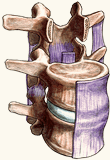Herniated Disc Diagnosis
Intervertebral discs are located in between each vertebra and serve as the spine’s shock absorbers. A tough outer band (annulus fibrosus) encases a rubbery substance (nucleus pulposus).

If the outer band cracks or breaks open, the material inside the disc can push out into the spinal canal, causing what is commonly referred to as a herniated disc. The disc material may place pressure on nearby nerve roots or the spinal cord. Additionally, nuclear material releases chemical irritants, causing nerve inflammation and pain. Sudden stress, such as from an accident, causing lumbar (lower back) disc herniations are rare. A herniated disc likely develops gradually, over weeks or months. The best test to have done is an MRI.

Conservative Treatment of Disc Herniation
Disc herniations can be managed with medications, therapy, as well as injections of cortisone via an epidural injection or a nerve block. While it is impossible to predict how long an injection will alleviate pain, 2 out of 3 patients who undergo nerve block obtain relief and never require surgery.
Microdiscectomy: Surgery for Herniated Disc
If conservative treatments don’t work, surgery is a good treatment option. The standard operation is called a microdiscectomy and can be done on an outpatient basis. Microdiscectomy is effective in reducing pain in over 90% of patients. Approximately 25% of patients obtain complete pain relief, while others may continue to have some, but usually significantly less, pain after this operation. Herniated disc can recur in about 1 in 10 people for reasons that are not clearly understood.
Massive disc herniations can cause severe nerve compression and lead to problems with bladder and/or bowel control. Numbness around the scrotum/labia and anus (saddle anesthesia) may be indicative of cauda equina syndrome. Although uncommon, symptoms include loss of bowel or bladder control and/or pain, weakness, or loss of feeling in one or both legs. This is a medical emergency. If you experience any of these symptoms, it is important to be seen by a physician right away. A more urgent or emergency operation will need to be performed if this is the case.




 Dr. Kwon specializes in treating adult spine disorders. Whether you’re suffering from neck or back pain, Dr. Kwon will provide you with all the information you need to make an informed treatment decision.
Dr. Kwon specializes in treating adult spine disorders. Whether you’re suffering from neck or back pain, Dr. Kwon will provide you with all the information you need to make an informed treatment decision.